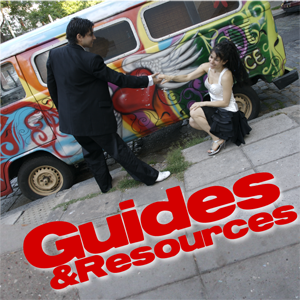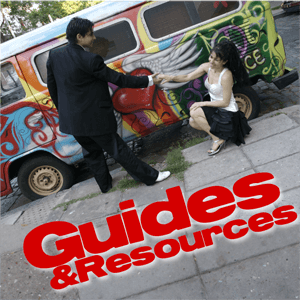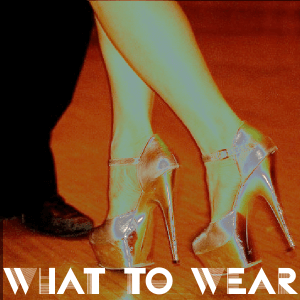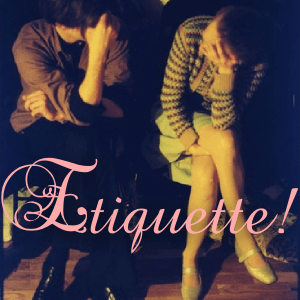Berlin is purported to be the #2 city in the world for Argentine Tango. No one knows what this means – number of dancers, level… It doesn’t matter, it’s well worth the trip.
This post began as a summary of my experiences in July and August, 2014, so it still has the flavor of a visitor’s view, although I’ve now updated it was a resident of 2+ years.
The section on Milonga Popular was updated on 10 April 2015. Roter Salon was updated in December 2016.
Please also note that the Berlin Tango scene is in a constant process of change, perhaps more rapid than other cities. It’s hard to keep up. I will intermittently update this post, but please treat it as only a rough guide.
Info on regular events (not always updated for special events, cancellations and changes): // tango.info/berlin
Special events: https://www.facebook.com/groups/berlin.tango/
The most reliable phone ap with daily updates is called Hoy Milonga Berlin.
What to eat!
*** If you have not already booked your trip, one piece of advice as you muse about a summer tango trip to Berlin. Summer is mild and lovely in Berlin, but the milongas are asphyxiating. Although the night air is wonderful, the milongas are located in residential buildings, so the windows are closed to prevent musicality annoyance to the neighbors. Just imagine the thickest walls and best insulation in the world – in summer with hundreds of tango heaters on the move. Although they’re champion insulators, Germans have yet to discover the air-circulating fan… Come in winter.
If you’re in a hurry, skip to for my recommendations by day of the week (updated 2017).
Introduction
Keep in mind the level in Berlin is pretty low. It’s a BIG scene, but not a high-level scene. Lots and lots of people here dance like beginners and have been doing that and having a great time for 6-7 years. Germans don’t have the ambition thing that Americans have.
What is special about Berlin is not level, but the diversity and the deep tolerance for self-expression. There are here significant numbers of people still dancing “nuevo” and still dancing on alt.music who won’t be bullied into conformity about such matters.
Women are respected as Marks, more than anywhere else I’ve danced. (2 of the first 3 people who danced and taught tango in Berlin were women. So there was never any question about whether women could do these things.) Men are also allowed to enjoy following. Anytime. Anywhere.
Shoes are optional.
The Fundamentalist (“traditional music is better/the ronda is the most important aspect of tango/ganchos are dangerous and ugly/open embrace isn’t tango”…) scene exists here, but there are few high-level dancers, so it’s a lot of attitude for nothing (it’s mainly focused on dancing with women in mini-skirts or pencil skirts tight enough to see cellulite). You can go where these people go, but you won’t have GREAT dances and you’ll miss what Berlin tango is about. (Anyway if you have great legs definitely bring and wear your shortest and tightest skirts here in Berlin.)
Orientation/translation
A “practica” here is a class. Teachers in the middle of the room, showing moves, after which everyone tries it. Repeat. What we call a “practica” (place to practice whatever you want, stop and talk to your partner about it, ask friends for help…) is called a “lab”, or doesn’t exist.
Water is not considered an aspect of health nor human rights. At milongas water is not free, but at classes water is sometimes provided for free.
Coffee and alcohol are considered sufficiently necessary to effective action that tango schools and milongas always have a café with espresso machine and a selection of wine, beer, etc. at affordable prices. Every milonga has a bar and that’s how they pay the rent, not from the door receipts. Moreover, Germans don’t view water as a health-related product, so they drink coffee, wine, and beer to keep hydrated, meanwhile supporting the bar. If you ask for water you will have to *pay* for bottled water at the bar. Nobody seems to bother you if you bring your own bottle, but you’ll have to fill it up in the restroom, and do keep it in your bag rather than leaving it sitting on a table or aggressive bar staff might confiscate it.
If you want to take a class (or attend a “practica”) you must arrange a partner in advance. Rocking up alone is not done, and will likely result in your sitting on the sidelines through the class. Even a mark cannot presume there will be an extra revel waiting around. The folks at the door will take your money if you give it to them, but no one will take responsibility for making sure you dance. The good news is that dancers are used to arranging partners, and will not interpret an invitation to go to class together as a romantic advance.
All gender-role combinations are normal and welcome at Berlin milongas. Revels are open-minded and positive about being asked to dance by women. Men will be dancing together, because they like it.
In Berlin, because the whole tango situation is more developed, there are different professional roles. Some people teach, others DJ, others host milongas, others organize special events, others run schools. It’s not necessary that anyone do more than one of these roles or be good at more than one of them.
A number of schools have permanent spaces, where they run classes (with rosters of up to 18 teachers, many of whom work at more than one school), milongas, and offer special events. The schools are not factions and territories. People may well go to milongas at a school where they’ve never taken a class.
People Dress Up. My impression of Germans in Buenos Aires led me to expect the Berlin scene to be informal. I guess those girls were just conforming to BsAs style. Berlin milonga attire is sexy, elegant, expensive, with lots of flesh in view. Satin, not stretch-jersey yoga gear. Miniskirts(!), not shorts. NO bluejeans. You can go shopping at TangoLoft.
 However, you don’t have to wear shoes. At many milongas you will find people taking barefoot dancing quite seriously. They often wear professional dance devices to ease pivoting, but duct tape will work in a pinch. If you want to try barefoot dancing, Berlin is the place.
However, you don’t have to wear shoes. At many milongas you will find people taking barefoot dancing quite seriously. They often wear professional dance devices to ease pivoting, but duct tape will work in a pinch. If you want to try barefoot dancing, Berlin is the place.
Berlin milongas are OPEN and busy on Holidays.
The scene(s)
There are, roughly speaking, two tango scenes in Berlin.
- Milongas with 100% traditional music, serious expressions on the faces, not very friendly to strangers, and very simple dancing.
- Milongas with 20-100% alternative/nuevo music, laughter and smiling, friendly to strangers, and complex, interesting dancing.
Get a copy of the excellent Berlin Tango Map (available at Nou Tango School, La Berlinesa, and milonga Max & Moritz). Each milonga reports music percentages. Anything under “100% Traditional” is a pretty sure guide to smiles.
At almost all of the larger milongas of Scene1, there is a table of queers and other dissidents from Scene2, who make their own fun anyway. (Update 2017: Almost all of the Queers have quit Scene 2 and joined Scene 1.) One of the nicest monthly milongas, if you catch it, is the Sunday Milonga Queer (formerly helded at Fincan, now at Art.13). Join the FB Group for details.
These scenes do not correspond to particular schools.
Another difference between the scenes is technical competence of the marks. In Scene1, the marks generally dance their small vocabulary of ochos, rebotes, and crosses with very nice rhythmic musicality and good technique. In Scene2, the marks often have big vocabulary including sacada, barrida, voleo, gancho, volcada, colgada, soltada, but weak technique. The level of non-professional revels in both scenes is quite weak.
Milongas
Almost all of the information you need is here: https://tango.info/berlin, except for some exclusive milongas which only advertise in facebook.
Below is a list of the milongas I attended, in order of preference. Because I was there during Summer, some milongas were closed.
My Favorite milongas

Clärchens Ballhaus: Scene1, attended and enjoyed by all. It reminds me of La Viruta, because there is a lot of power and freedom in the room (perhaps because excessive seriousness is disrupted by waiters and restaurant patrons lurching across the dance floor). Upstairs in the same building is a *gorgeous* room where the Spiegelsaal Scene2 milonga is held intermittently on Thursdays. Clärchens serves overpriced, awful food, but the Tuesday milonga is free. Update 2017: The Weekly Tuesday milonga is now held upstairs in the gorgeous Spiegelsaal and there no additional intermittent milonga. Entry is no longer free (€4). Bring as little personal stuff as possible here, I’ve had my wallet stolen in the restaurant room and my phone stolen in the private upstairs room. And they have no lost and found, so if you leave a sweater, it’s also gone…

TangoLoft: Scene2, attended and enjoyed by all on Saturday (2100-0400) and Sunday (1500-0230*) evenings. This milonga is so the way it should be that I cried in shock the first time I visited. Lots of girls dancing together, men skipping and giggling, all kinds of whimsical and luscious music, soltadas everywhere, a board with shared bread, a kitchen serving affordable supper of gnocchi or ravioli and salad from about 21:30 until they run out of food, big bouquets of fresh flowers, couches, candles, cats. Nobody watching much. People dancing for themselves full stop. Please see Thomas Conte’s album of photos of TangoLoft. This album truly captures the spirit of this place. My interview with founder, Henning Klose.
* Sunday closing time is advertised as 0400, which sounds convenient for staying up all night until the Ubahn opens, or until your early morning flight. But don’t count on this. In practice, they almost always close by 0230.

Art. 13 “Beginners” Milonga: The name of this milonga is misleading. It’s dark, intimate, with candles and nice, nice dancers who work hard on on their technique under the serious tutelage of Sebastian and Chantal of Art.13. Zero attitude here, which draws openminded dancers who are not students of this school.
Roter Salon: Beautiful room with comfortable upholstered furniture. The onda here is – happy. Michael Rühl’s 100% traditional music is always charming. The dancing can sometimes seem lethargic, but people are basically into what they are doing with their partner and not overly concerned about what you are doing. It seems unfriendly and awkward at first, but everybody seems to end up dancing. Be sure to dress up for this one. The perfect place to go dancing on a romantic evening when you plan to dance the whole evening with your partner, need a couch to make out on, and are drunk/high enough not to be affected by the fact everyone else is doing the same. Often poorly attended. Closing hours vary.
Milonga Popular: Updated review 10 April 2015. Milonga Popular has moved to a larger room.* People are more friendly than previously, and Scene 2 has started to show up, which means the dancing and attitude is more diverse. The agenda of this milonga is to be like a pop dance club. The evening is divided into three sequential zones. First is traditional music with cortinas cut from pop dance music. At around 01:30, the tango music stops, everyone is invited to make themselves a free drink at the bar (vodka, rum, and mixers are offered) and for 30-45 minutes, only pop music is played. Sometimes there’s salsa, live guitar, or chacarera. The pop music is played until nearly everyone is boogying on the floor, and then for a while after that point. Eventually, tango music is returned, but during the third zone, the pop cortinas are played in full, and people dance tango+ to them. Many people change their clothes and shoes during the second zone and continue in more informal attire. During the third zone, open-minded dancing and flexible embraces appear. People admit they’re pretty drunk, and that’s ok.
* There is still very little seating, and revels are left to lean against the walls while waiting. There is also a poorly-insulated and well-used smoking room next to the bags/coats/changing room, so whatever you leave there will reek afterwards.
Ok milongas
Tango Tanzen Macht Schön (Best name of any tango school, “Tango Dancing Makes You Beautiful”): Scene1 milonga on Friday nights. Difficult dance floor, due the the fact people are seated on three sides of the floor in a way that their toes are in lane1. In an attempt not to step on toes, lane1 dancers edge 20cm into lane 2, constantly crashing with the dancers who are using it. The resulting traffic is consistently chaotic and distracting.
Walzerlinksgestrickt (Nicest and largest mirror of any milonga): Scene1 milonga on Saturday nights. Ok if you go with friends. Cabeceo doesn’t work well here for strangers. There’s no cabeceo place. All the seating is spread out and dark. But once you’re dancing, the atmosphere on the floor is nice. DJ Michael Rühl.

Nou Tango School has a milonga for Scene2 on Mondays and Scene1 on Fridays. On the Mondays I visited, the power was always a bit low, but the music is great and people are enjoying themselves. It’s a very, very comfortable atmosphere. Cabeceo is easy, because you can easily see across the room. On Friday, the column near the bar divides the elite from the hoi-polloi, so you know where to put yourself. My interview with founder Thomas Rieser.

Mala Junta has two milongas for Scene 1 (although the school certainly caters to Scene2), on Wednesday evenings and Sunday afternoons (called Café Dominguez, reputed to throw people out for bad behavior). I didn’t go on Sunday, and the two times I went on Wednesdays were dramatically different – one was packed and lively, the other was almost empty and dreary. But the organizer and DJ were very, very welcoming and even invited all who made it to the end to “have a drink with us.” This milonga impressed me by replacing the candles even to the very end of the evening. That’s style! The room and seating is comfortable. Cabeceo is easy here, because you can easily see across the room.

Strandbar in the Monbijoux Park is wonderful because it is outdoors in a beautiful, relaxed setting and everyone is so happy to be there. Crowded, happy, messy. Tourists smiling at the dancers, some of them try to dance which some people find annoying. (Theft is a problem here so bring the minimum and pile your stuff over by the DJ but do bring your own Water! The plywood floor will eat your shoes, so best to do something like put duct tape on your street shoes.) There’s various partner dancing nearly every night of the week here during summer. In 2016 tango nights were Wednesday and Sunday and a few hours on Saturday afternoon (16:00-20:00?). There’s pizza and a bar. You have to pay a deposit on glasses. (If someone swipes your empties before you can return them, it starts to feel expensive)
Tango Vicioso is held at the Insomnia sex club, which puts some people off, but Scene2 shows up in interesting clothes to dance to interesting music and then goes home without incident.
Max und Moritz is the “high-level” milonga where many professionals go to dance on Sunday nights. The dance floor is energetic and inspiring, but tiny, so lesser marks need to watch themselves so as not to disrupt the flow of serious tango business. Unknown revels might have a hard time alone here. If it’s overwhelming, just go have a drink in the pretty bistro-style bar at the front.
Milongas I don’t like so much
Villa Kreuzberg is a beautiful room in a beautiful building in a beautiful park, with romantic tables outside to escape for a conversation. It’s Scene1 and the power is highly variable. But Scene2 shows up, if they feel like it, and makes it their own. My general sense here is that it’s the end of the world and everybody is about to die.
Pfefferburg is Scene1 and open air, but the floor is made of the same material they make roller skating rinks from and I didn’t feel safe standing on it. Dancing was impossible. I gave up and had a beer under the trees. I did not get the sense that it was welcoming to strangers.

Bebop: One of my favourite things about Berlin is high ceilings. Bebop is like being inside an air-conditioning duct. It’s long and flat, and very slippery (to make sure you don’t get stuck?). There are very artistic lamps to distract you, several different kinds of furniture to choose between, and a river outside (cooling, with a view of corporate logos). Bebop is Scene2 and to be congratulated for welcoming the monthly Queer Tango milonga.
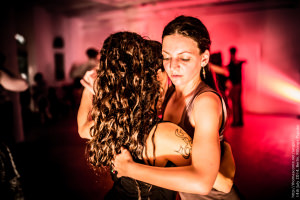
Other things to know
- You can always get home. Berlin has fantastic public transportation. Trains run all night on Fridays and Saturdays and until about 01:15 the other nights, when All U lines are replaced with Night buses running the same routes every 30min, so if you are close to a U, you can get home easily and cheaply without even researching beforehand. (There are other night buses too.) If you don’t have a bus ap on your phone, just walk to a bus stop and look at the N routes. Every stop is listed and if you read patiently you’ll see something familiar. Once you’re on the bus, the upcoming stops will be displayed so you’ll know when to get off.
- To get a sense of the central city, ride the trams.
- There’s a special monthly transit pass for tango dancers. You save about 25% by promising never to ride before 10am.
- Don’t taxi from the airport either! Both airports are well and cheaply connected to everywhere. At the airport machines, buy a one week AB pass which gets you unlimited subway, tram, and buses and then buy an “extension ticket” just to get off the airport (because the airports are C zone). If you come in at Schonefeld for some reason the lines for buying train tickets are very long sometimes. There are two tricks: 1. buy it inside the airport (there are machines) OR go all the way to the train *platform* and use the machines there which everybody seems to forget about.
- Berlin is fairly affordable for eating out. Food’s not great, but at least you’re not pissed off about what you paid for it. Lots of vegan options in regular restos here if you need that sort of thing. Lots of bio (organic) shops too.The level of falafal is fantastic, so you can afford to eat. And even late at night, you can get fairly healthy food.
- Milongas and transit are OPEN on holidays, but EVERYTHING else, including the grocery store, is CLOSED on SUNDAY and holidays. So especially if you visit during holidays, be sure to plan ahead.
- There’s a gourmet local (“bioregional”) scene, but you need to know where to go. The best is “Street Food Thursdays” 17:00-22:00 at Markthalle IX in Kreuzberg.
- In the summer it is de rigeur to have an ice cream cone every two hours throughout the day. The portions are small, enabling you to keep up without difficulty.
By day of the week
In my view Sunday through Wednesday are the best nights and you will find me at the places I recommended for Sundays, Tuesdays, Wednesdays. (I am inconsistent about Mondays.) If you have non-tango appointments for dinner with friends etc. schedule those Thursday-Saturday.
Sundays
If you want to find the Fundamentalist self-appointed elite, they do a very strict (no voleos) afternoon milonga called Café Dominguez at the school Mala Junta on Kollonenstraße in Schöneberg from 15:00 to 21:00 or thereabouts. 100% traditional music.
The BEST milonga of the week is Berlin’s beloved Tangoloft Sunday 12 hour milonga from 16:00-04:00 at Gerichtstraße 23 in Wedding. According to Eugenia Parrilla, it’s “the most beautiful milonga in the world” in ways that I won’t even try to describe to you so that it can be a surprise. Dancers of ALL levels and styles come here. The music is 50% traditional. There’s cake in the afternoon and supper later on. Three or four shifts of dancers come through and some stay for 9 or 10 hours. I usually arrive at around 22:00 and stay until 02:00. What is especially notable to experience here is that the dancers are joyful, rather than sour, and the women are not hungry and powerless. This I credit to the organizer, Mona Isabelle, who conveys a glamorous image of women being responsible for their own pleasure. There are a lot of amazing things in the Tangoloft, and she is the Jewel who is a not to miss experience.
For a head-spinning contrast, do both.
Mondays
Milonga Popular, Mehringdamm 61 through the dark courtyard to the open door, then up a few flights of stairs until you hear music behind a white door…
This is one of the most important milongas in the world which is actually figuring out how to popularize tango with young people by creating a “party” atmosphere. The first milonga (100% traditional music) runs from 21:30-01:00ish, finishing with La Cumparsita, at which point there are free drinks. After this is a mix of dance music, tango (70%), performance art, and people feeling free to use the dance floor as they want. You may or may not like elements of the evening, but it is an important and successful effort in figuring out how to make tango relevant and attractive to the next generation. Early in the evening the floor is very full of beginners (who are encouraged to stay on the milonga from their very first class!), but the level improves steadily as they tire until 04:00. For full touristic benefits, I recommend taking a nap and then arriving at 23:30 and staying until 03:00 or the end, when the trains start running again (04:15). Note: this milonga is not listed in any guides. If you feel the need to check, info is here: https://www.facebook.com/groups/275166282588468/. If you want to hit two milongas, you can start early at the Nou School Monday night “lounge”. It’s 50%/50% music. I think of this place like El Motivo c. 2010, very few people there, but open-minded, and if there is anybody worth dancing with you will get to. I haven’t been to this one since MPop opened last year.
Tuesdays
Spiegelsaal in the Clärchens Ballhaus, Auguststraße 24 in Mitte. This is one of the most beautiful and historic rooms you will ever dance in. There has been tango in the Clärchens for 15 years, and the Spiegelsaal was the site of decades of important and intriguing historical and political events. 100% traditional music. People are a mix of the snooty people from the School called “Nou” and people who just love the room and will dance there at every opportunity no matter what. 21:30-02:30… Usually quite full at 23:00 with great atmosphere until 02:00.
Wednesdays
Roter Salon in the Volksbühne at Rosa-Luxembourg Platz in Mitte. This is the weekly milonga of one of Europe’s most revered DJ’s, Michael Rühl. He was one of the very first people to organize a milonga in Berlin in the early 1980s (and also one of the first festivals in Europe) and this milonga is set to celebrate its 20th? anniversary. The room is gorgeous, the music is fabulous. 100% traditional. 21:30-02:00… Not always well attended, but people who go there really want to dance, so you WILL dance. It’s easier socially than Tuesdays.
The Café Dominguez people have a second milonga on Wednesdays called El Ocaso, but even people I know who like CD say that it’s dreary. I think the room is particularly awful. Some people do El Ocaso early and then move on Roter Salon. It’s a 20 minute walk.
A BETTER Berlin tango tourist action for early evening Wednesday would be Tango Vicioso. It happens every other Wednesday…. This is tango in a Sex Club. It’s a thing in Berlin to have tango in sex clubs. (The usual patrons are not using the tango room.) Check the schedule: https://www.facebook.com/tangovicioso
Thursdays
This is not a great night in Berlin. There is a milonga at the Villa Kreuzberg in Schöneberg which is in an old room, but every time I go there I feel it’s the end of the world and everyone is about to die. Some people like it, and some people like the music, but I don’t. Nothing about it is “don’t miss this!” so if you need to take a night off from dancing, this would be the one to miss. There is also another milonga very close by called Mambita. It is a boring modern room, but here you can get a taste of the die-hard Berlin scene of people who refuse to dance to traditional tango music. Better to hit this one on the early side. At 23:00 it’s already emptying.
Fridays
There are three choices, and you can actually go to both of the first two as they are only a few blocks apart. The school Art.13 is the best school in Berlin in that they consistently train students with gentle and nice embraces. Their Friday night milonga is a “beginner’s milonga” but everyone always has a good time, and plenty of the more advanced students, or open minded people, go here on Fridays. The music is never loud enough but it’s great to be with gentle and hardworking dancers. Not much macho here. The people who become the best dancers in Berlin come out of this school. Dresdener Straße 11 in Kreuzberg near U-Kottbusser Damm. Ring the bell for the school and the door automatically buzzes open. Then go to the 2nd door on the right and buzz again. Music is 50% traditional.
Around the corner at Oranienburger Strasse 185 is Tango Tanzen Macht Schön, which is an unremarkable school and milonga who has a great name (Tango Dancing makes you Beautiful). It’s well-attended, but nothing special here. 100% traditional music.
Also on Friday night is the milonga of the Nou School (same people who run Tuesdays, but very different atmosphere). If you are looking for Berlin’s self-appointed elite (who are very boring dancers with a lot of attitude, as is in fashion at the moment), you will find them here, on one side of the room, with the hoy poloy segregated at the other. 100% traditional music. I know people who have a good time here, but I stopped going because I can’t stand this attitude.
Saturdays
If it’s on, the Pippo’s afternoon milonga is a local grunge close embrace favorite in a bar in Neukölln (sometimes in Wedding, be sure to check). I haven’t been there, but my friend likes the rooms. 100% traditional music. Might be hard to break in here, but maybe not. Updated infos here: https://www.facebook.com/groups/PippoTango/
At night is Michael Rühl’s second milonga. You need to do some research to check the location. It moves back and forth from the Walzerlinkgestricht in Kruezberg or the Rixdorf in Neukölln. These are big rooms, formal milongas. A basic, big, reliable milonga, where you can sit comfortably, and the tourists go there so you always dance. And the music is good. 100% traditional.
You can read my interviews with Rühl, Rieser of Nou, Sven/Pedram of Milonga Popular, Mona Isabelle, and others here: The Berlin Interviews

